Best Guitarists Of All Time We have assembled a list of must know guitarists who we believe fall into the category of “Best Guitarists Of All Time”. This is of course is not an exhausted list, and we will continually add to the list as time goes on. Here is a well rounded list of...
GuitarBest Guitarists Of All Time
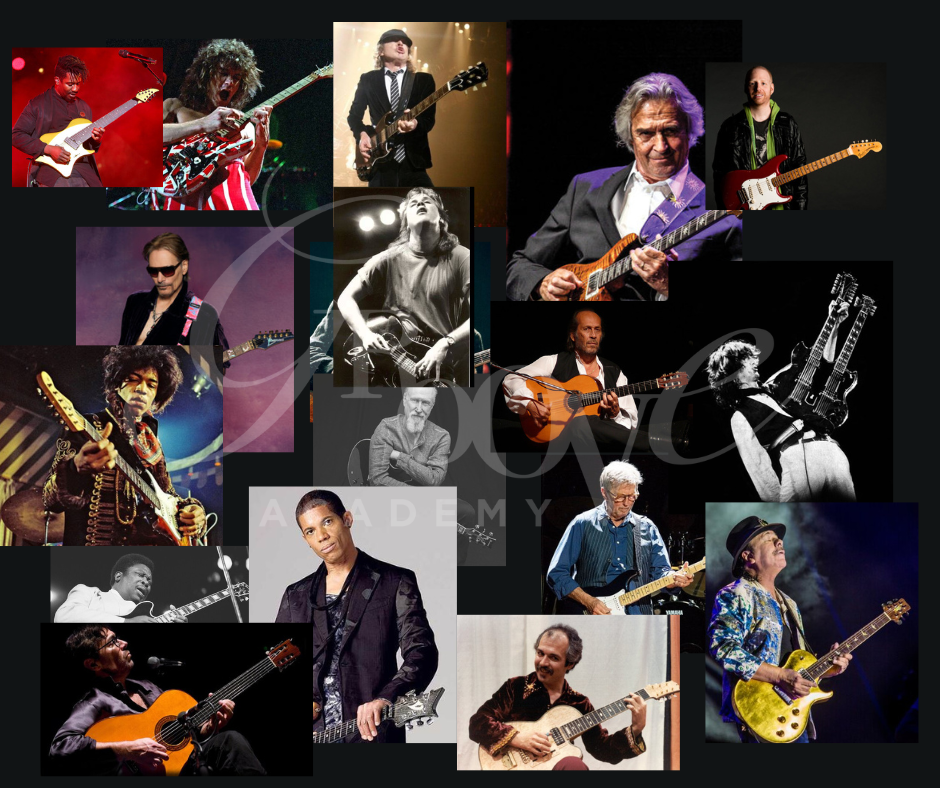
Best Guitarists Of All Time
We have assembled a list of must know guitarists who we believe fall into the category of “Best Guitarists Of All Time”.
This is of course is not an exhausted list, and we will continually add to the list as time goes on.
Here is a well rounded list of must know guitarists, and we have included all styles of guitar playing.
Eddie Van Halen
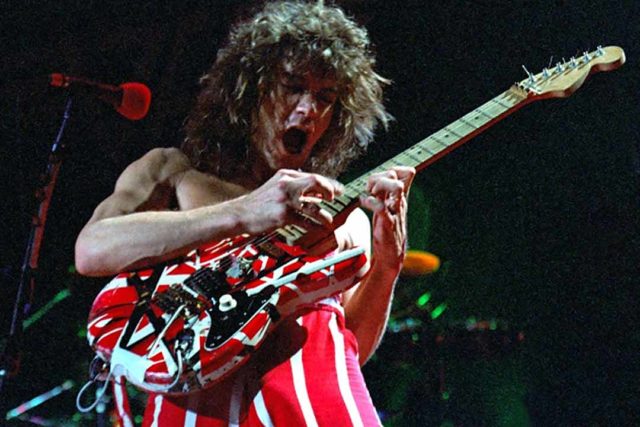
Rock guitarist Eddie Van Halen was born on January 26, 1955. Originally from the Netherlands, his family moved to California when was young. Van Halen actually started his musical journey by playing piano as a child. He never actually learned music theory or scales. Instead, he watched recitals of Mozart or Bach and improvised at the piano. He was able to win first place in local piano competitions where he lived in Long Beach. Although his parents wished for him to be a classical musician, Van Halen was passionate about rock music.
He formed his first band called The Broken Combs with three friends and his brother. Performing with this group at school is what made him want to do music professionally. In 1972, the band’s name was changed to Van Halen, and they began playing at well known venues like Whiskey A Go Go. The group in 1978 released their first album under Warner Brothers, and by the early 80’s they were a very successful rock band. In 1992, the group won a Grammy for Best Hard Rock Performance with vocals.
Van Halen became inducted into the Rock and Roll Hall of Fame in 2007 for his guitar work with the band. Eddie was known for using the tapping technique, or playing the neck with both the right and left hand. He was widely respected for his guitar playing, and was recommended to Michael Jackson to play the solo on “Beat It.” His solo on the single “Eruption,” was voted number two out of 100 best guitar solos in Guitar World magazine. His original guitar was a Gibson Les Paul, but he also used Frankenstrat, and Wolfgang USA. His equipment was often custom made. He was also awarded three patents for guitars. Van Halen unfortunately suffered from throat cancer, and passed away at the age of 65 due to a stroke.
John McLaughlin
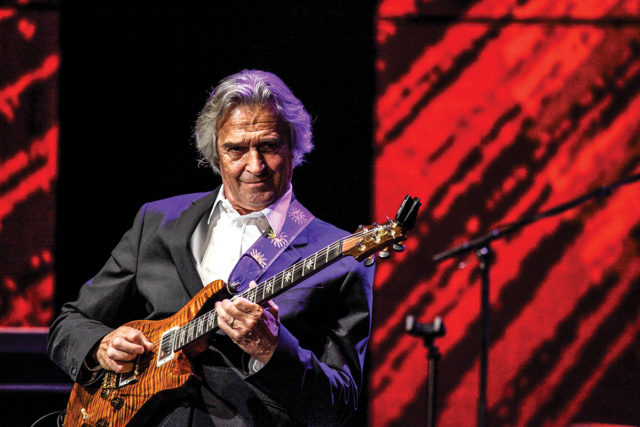
Born on January 4th, 1942, jazz fusion guitar player John McLaughlin was born in England. He studied guitar from the age of 11, though he started taking piano and violin as a younger child. His early acts consisted of playing with Alexis Korner, Brian Auger and Georgie Fame and the Blue Flames. McLaughlin became well known as a session player, playing on albums with artists such as the Rolling Stones. McLaughlin has been active in the music world since 1963.
His first debut album, Extrapolation, came in 1969. After that came the psychedelic fusion album Devotion in 1970. In 1973, he collaborated with Carlos Santana on an album called Love Devotion Surrender. In the 1970’s McLaughlin formed an electric band called the Mahavishnu Orchestra. This group infused Indian music with rock and jazz, and this helped fusion to become a growing style of music. McLaughlin tended to use several Gibson guitars over the years.
He became a leader in the world of jazz fusion and jazz guitar playing, even collaborating with Miles Davis on several projects. With his technical precision, speed, and fusing together of classical, jazz and Indian music, McLaughlin was incredibly influential. He has won many awards, including a Grammy for Best Improvised Jazz Solo in 2018, as well as Guitarist of the Year from magazines such as Guitar Player and Downbeat.
Steve Vai
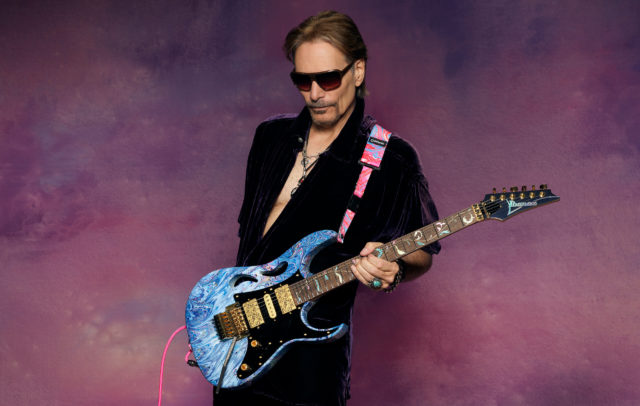
Guitar virtuosi Steve Vai was born on June 6, 1960 in New York, although his family descended from Italy. He discovered music at the age of five with piano. At the age of six, he saw a boy in his school playing guitar, and he was immediately drawn to it. He started guitar lessons at age 13, and claims that guitarists such as Brian May, Jimi Hendrix and Jimmy Page were influences for him. Vai was accepted to the renowned Berklee College of Music, and while there, began work for Frank Zappa as a transcriptionist and also toured with him.
His first album, titled Flex-Able was released in 1983, and his piece “The Attitude Song,” had him rise to fame. It features techniques such as alternate picking, sweep picking, two handed-tapping and odd phrasing. Vai joined David Lee Roth’s band after that. Their album Eat ‘em and Smile was a success. During this time, Vai created the JEM guitar, a different kind of instrument that has now become common in the guitar world.
At his home studio, The Harmony Hut, from 1985 to 1990, Vai recorded Passion and Warfare. Firegarden followed after that. Vai also was the winner of the 2001 Grammy for Best Pop Instrumental Album, having played guitar on Joe Jackson’s Symphony Number One. Most notably, Vai started the Make a Noise Foundation, which helps to give music education to people who cannot afford it. He has also composed and arranged orchestral pieces.
Recently, Vai has released his 10th studio album, and continues to wow audiences with his amazing skills.
Stevie Ray Vaughn
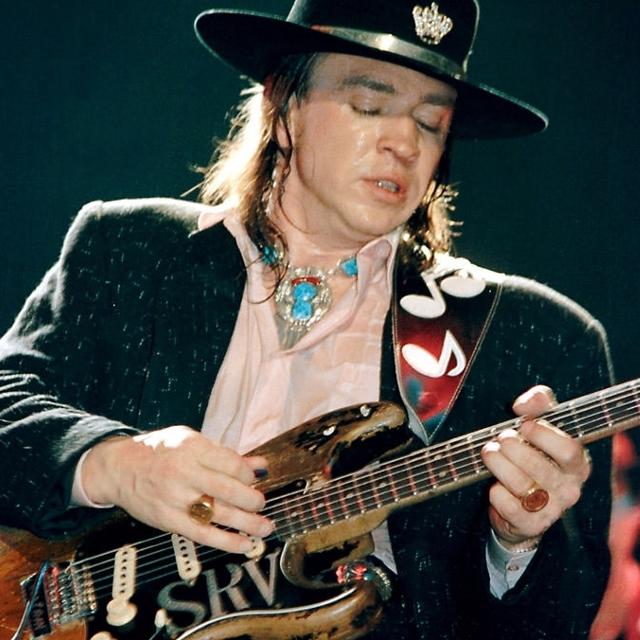
Blues guitarist Stevie Ray Vaughn was born on October 3, 1954. He was an incredibly influential musician and guitarist in blues history, even though much of his career only lasted seven years. Stevie was born in Dallas Texas, and started playing guitar when he was seven. Neither of his parents were musical, but his older brother Jimmie had an interest in music and instruments which inspired Stevie. Stevie listened to many blues artists such as Muddy Waters and Otis Rush, and rock guitarists like Kenny Burrell and Jimi Hendrix. His first electric guitar was a Gibson ES-125 that had belonged to his brother.
Stevie moved to Austin in 1972 and played several gigs at local clubs. He met Chris Layton and Tommy Shannon, and the three became the trio Double Trouble and one of the most well known acts in Austin. Their performance at the Montreux Jazz Festival was notable. Although the crowd was not all receptive to his music (some of the audience actually booed), everyone wanted to know who he was afterwards. Double Trouble’s first album Texas Flood, achieved commercial success with songs like “Love Struck Baby” and “Pride and Joy”.
David Bowie asked Stevie to record on his next studio album, and he played guitar on six out of the eight songs on the album, including “China Girl.” Stevie went on to become one of the most famous and in demand blues guitarists, even heading Madison Square Garden in 1989.
He also used techniques from Jimi Hendrix like playing the guitar with his teeth and playing behind his back. Stevie also used tremolo picking and vibrato in his playing. His favorite guitar was the Fender Stratocaster for its strong tone and durability. He also helped in the revival of vintage amplifiers. Stevie played with a loud volume and the heavy strings needed powerful amplifiers. To shape his overdriven sound, he used Fender Super Reverbs.
Stevie was inducted into the Blues Hall of Fame in 2000, and also won five W.C. Handy awards. Sadly in 1990, Stevie died in a Helicopter crash.
Eric Clapton
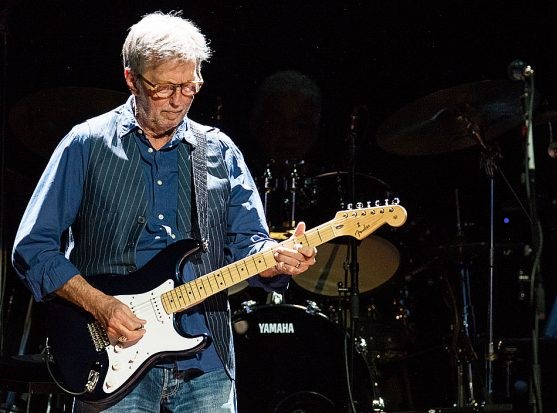
The influential rock and blues guitar player Eric Clapton was born in Ripley, Surrey, England on March 30 1945. His mother was only sixteen at the time of his birth and his father was drafted to war before he was born. Clapton grew up with his mother and grandparents in England. When he was thirteen, Clapton received an acoustic guitar for his birthday, but found it very difficult to play. He picked it back up again when he was fifteen and started playing every day.
Largely influenced by blues music, he practiced to a lot of blues records for hours each day. After he was expelled from College in 1961, Clapton began busking around town and started performing duets with Dave Brock in local pubs. He joined his first band Roosters in 1963. Influenced by blues guitarists such as Freddie King Robert Johnson, and B.B King, Clapton joined the Yardbirds and became known for his distinctive guitar style.
In 1966 he joined the psychedelic group Cream. At one of their performances, Jimi Hendrix joined the group, and his influence had an important effect on Clapton. With tunes like “White Room,” and “Sunshine of Your Love,” Cream became a huge success, selling millions of records. However, with disputes amongst band members and substance abuse, they soon fell apart. Clapton went on to become a successful solo artist, with hits such as the well known “Layla,” and “Tears in Heaven.” Clapton has become regarded as one of the most influential guitar players in the world, and was the only one to be inducted into the Rock and Roll hall of Fame three times. Guitars Clapton used include a Fender Telecaster, Gibson, Gibson Firebird, and Fender Stratocaster. The Eric Clapton Stratocaster was introduced by Fender in 1988.
Clapton has won numerous awards for his musicianship including three Grammys. He continues to play and tour even today.
Jimi Hendrix
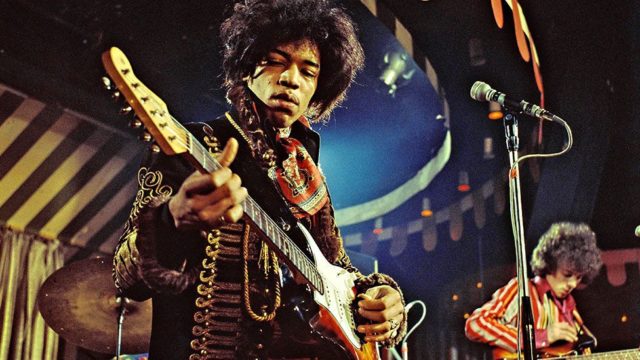
Jimi Hendrix, one of the most influential electric guitarists in music history, was born on November 27, 1942 in Seattle Washington. With his father in the war, his mother struggled to raise Hendrix and his siblings, so he spent a lot of time with different family members. His first instrument was a one-stringed ukulele in which he learned to play single notes on, most notably to Elvis’s “Hound Dog.” Hendrix obtained his first guitar at the age of 15.
While listening to musicians like Robert Johnson, B.B. King and Muddy Waters, he played for hours every day. Billy Davis, guitarist for Hank Balllard and the Midnighters, showed him a few tricks on guitar. Hendrix formed the Velvetones, his first group. Because he was on acoustic guitar at the time, he could hardly be heard. His father then decided to purchase him his first electric guitar, which was a Supro Ozark. Hendrix was so devoted to guitar playing that he begged his father to send him his guitar when he was drafted into the military. He was discharged in 1962 as he neglected his duties and was not viewed as a suitable soldier. Once he was discharged, he then formed the group the King’s Kasuals.
In addition to his own groups, Hendrix did backing guitar for acts like Ike and Tina Turner. In 1964, he decided to completely venture out on his own, as he did not enjoy following rules of band leaders. And, in 1965, on Nashville’s Channel five “Night Train,” he provided guitar backup on the song “Shotgun,” with Little Richard’s band. In 1966 Hendrix moved to England where Animals bass player Chas Chandler became his manager. With his new group the Jimi Hendrix Experience, he celebrated three top ten hits, “The Wind Cries Mary,” “Purple Haze,” and “Hey, Joe.” After his performance at the Monterey Pop Festival, Hendrix achieved fame in the United States and his album, “Electric Ladyland,” topped the charts at number one.
He also headlined the Woodstock Festival in 1969, being the highest paid performer at that time. His performance on the “Star Spangled Banner” went down in history, with the usage of feedback, sustain and distortion to sound like bombs and rockets. Hendrix loved electric blues and rock music. He used amplifiers with a lot of volume and feedback. He also favored fuzz distortion as an effect, as well as wah-wah and uni-vibe. In his recordings, Hendrix was the first to use stereophonic phasing. He received many honors, with many magazines voting him rock guitarist of the year, pop musician of the year, and was inducted into the rock and roll hall of fame in 1992.
Hendrix favored the Fender Stratocaster as his guitar of choice. He liked the brightness and deepness of it. He also used Gibson Flying Vs, and Gibson Les Paul. Influenced by the rock group Cream, Hendrix was known for using the “wah-wah” pedal for effect, and his opening of “Voodoo Child,” has one of the best known “wah-wah” riffs. Sadly, Jimi Hendrix passed away at the age of 27 from asphyxia.
He is still credited for forever changing the sound of rock and roll.
David Gilmour

Pink Floyd’s David Gilmour was born in Cambridge, England, on March 6, 1946. Though his parents were not musical (his mother was a teacher and his father gave lectures in zoology), they did encourage his interest in playing music. The Everly Brothers got him interested in the guitar.
On a borrowed guitar from a neighbor, Gilmour taught himself how to play by using a record set and book. He did not enjoy school, but met future bandmates Syd Barrett and Roger Waters there. At college, he spent his lunches practicing guitar. Gilmour joined Jokers Wild, a blues rock band in 1962. In 1965, he busked in Spain and France with friends. With his old schoolmates, Pink Floyd released their first album called “The Piper at the Gates of Dawn”. Future albums The Dark Side of the Moon, Wish You Were Here, Animals and The Wall were all commercial successes. “Comfortably Numb,” “Another Brick in the Wall” and “Shine on You Crazy Diamond,” are all standout tunes on these albums.
When Gilmour became band leader. he aimed to create more of a balance between lyrics and music on the next albums. To showcase more of his amazing guitar talent, Gilmour has also recorded four solo albums. All of them placed within the top 40 in the United States. He also has taken on record producing for acts such as Elton John, Eric Clapton, and Paul McCartney to name a few. Gilmour has stated his influences to be Eric Clapton, Jimi Hendrix and John Fahey. He copied a lot of what they did, and from that came his own style. He used large guitar riffs, rich chords and long intense solos like on “Comfortably Numb.”
His style also reflects blues and bending notes, though his fingers were not fast. He developed a distinctive, recognizable sound that was not as flashy as someone like Jimi Hendrix, but full of emotion. Gilmour was inducted into the Rock and Roll Hall of Fame in 1996. Songs “Time,” “Money,” and “Comfortably Numb,”were voted in the magazine Guitar World in the top 100 guitar solos of all time. A supporter of various charities, Gilmour has shown support for mental health and illness, cancer, and the ethical treatment of animals. He has even auctioned off his own personal guitars in support of causes. When Gilmour turned 21, his parents gave him his first Fender guitar. In most concerts and on all Pink Floyd albums, he used a Fender Stratocaster, or Black Strat. Gilmour has also used Gibson Les Paul, and the Gretsch Duo-Jet.
He has eight children and still is active as a musician.
Chuck Berry
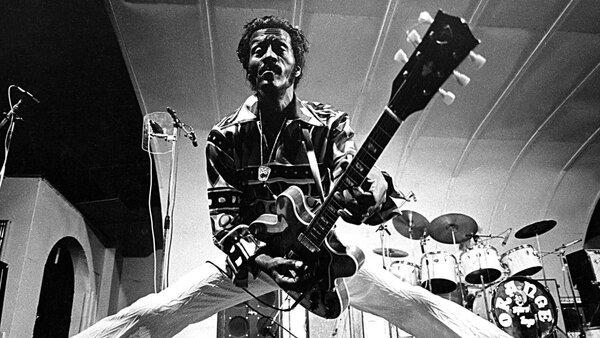
Known as the “Father of Rock and Roll,” Chuck Berry was a guitarist and pioneer of rock and roll. He was born on October 18, 1926 in St. Louis. The youngest child in his family, his mother was a school principal and his father a contractor. He was interested in music at a young age, giving his first performance in high school. He liked to play blues, borrowing riffs from T-Bone Walker, as well as showmanship ideas. His friend Ira Harris also gave him guitar lessons.
Berry began working with bands in the 1950’s for extra money. He joined Johnnie John’s Trio in 1953, playing ballads, country, and blues. Berry’s singing style represented Nat King Cole, and after a while, the band’s audiences grew larger. With the recommendation of Muddy Waters, he contacted Chess Records Leonard Chess when he travelled to Chicago in 1955. Berry then recorded the famous “Maybellene,” which reached number one on the Billboard Charts and sold over a million copies. “Roll Over Beethoven” climbed to 29 on the Billboard charts.
Berry became an established celebrity with both film appearances and hit records by the late 1950’s. “No Particular Place to Go,” “You Never Can Tell,” and “Nadine” were hits in the 1960’s. In 1973 he was a guest host on the popular show “Midnight Special.” In the 1980’s, Berry still performed 70 to 100 shows per year. 2008 he organized a tour of Europe, but had to be helped offstage due to exhaustion. Berry passed away on March 18, 2017 due to cardiac arrest. He was known for playing the Gibson Semi-Hollow bodied guitars, but favored his ES-355 model.
Berry was incredibly influential on both the attitude and music of rock and roll. He helped to develop rhythm and blues, and used showmanship techniques and guitar solos that would become a huge influence on future rock bands. Chuck Berry was known for his “duck “walk” routine, and his one-legged hop routine, which influenced AC/DC guitarist Angus Young. He also incorporated electronic effects on the guitar. The lyrics of his songs appealed heavily to teenagers.
Many future artists have done covers of his songs including Rolling Stones, Beatles, AC/DC, Elvis, and David Bowie. Berry received the Grammy Lifetime Achievement Award in 1984, a huge honor. He was also one of the first rock guitarists to be inducted into the Rock and Roll Hall of Fame.
Berry will forever be remembered as a true originator of rock music.
Angus Young
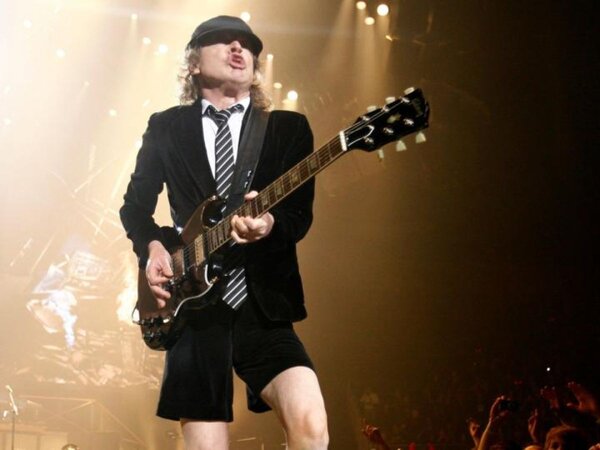
Energetic performer and rock guitarist Angus Young was born on March 31. 1955 in Glasgow, Scotland. He spent his early childhood in the district of Cranhill and had seven other siblings. The whole family was involved in music, playing guitar, accordion, piano and singing. Angus picked up the guitar at age six and was helped out by his brother Alexander, though he was largely self taught. After a terrible winter in Scotland, the family moved to Sydney, Australia in 1963.
In High School, Young only liked art classes and dropped out at age 15. He practiced guitar every day after school at home. The first guitar he purchased himself was a second- hand Gibson SG, which he played until it literally rotted. Angus and brother Malcolm formed the famous rock group AC/DC in 1973. They became a well-known hard rock band with numbers like “T.N.T,” and “Dirty Deeds Done Dirt Cheap.” “Highway to Hell,” became their highest-selling album and they became known world-wide after that. AC/DC was inducted into the Rock and Roll Hall of Fame in 2003. Australian Guitar Magazine named Young best Australian Guitarist in 2012.
Young was influenced by Little Richard, Chuck Berry, Muddy Waters and Keith Richards. In Young’s playing, power chords can be heard on songs like “T.N.T,” but a lot of the playing is based on 12-Bar blues progressions, and one handed (pull-off) arpeggios. Young liked the simplicity of the music of AC/DC, believing the average person on the street could identify with it. Young often wore a schoolboy uniform on stage and was known for his wild stage presence. He often ran back and forth across the stage, did high jumps in the air, and impersonated Chuck Berry with his famous duck-walk.
Guitars Young is known for are various forms of the Gibson-SG, and the Jaydee SG. Young is still active musically.
BB King
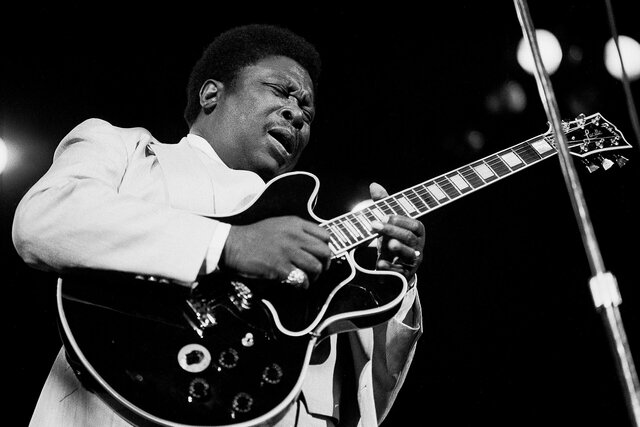
B.B. King is one of the most important and influential blues artists of all time. Born on September 16, 1925, King was born in Itta Bena, Mississippi, and experienced both music and guitar in church. Raised by his grandmother, he also sang in the gospel church choir. His local minister taught him chords on the guitar, though King was largely self-taught. He first performed on the Memphis Radio station WDIA. Once he owned an electric guitar, his own band called the B.B. King Review was formed.
King was not proficient at chords, and instead preferred to improvise. After their recording contract, they toured the United States. The songs “3 O Clock Blues,” “Every Day I Have the Blues,” and “You Know I Love You,” hit number one on the Billboard charts. For his version of “The Thrill is Gone,” King won a Grammy Award. He toured extensively and was later signed to ABC Records. In 1980 he was inducted into the Blues Hall of Fame, and in 1987, the Rock and Roll Hall of Fame. He is also a recipient of the Polar Music Prize.
King remained an active musician until his death in 2015. He performed 300 shows per year and made many television appearances including Married With Children, Fresh Prince of Bel-Air, and Sanford and Son. His style of soloing was very sophisticated, and included staccato picking that was influential on many other electric guitar players. He also included vibrato and string bending. On recordings, King used a Fender Esquire guitar, but was very well known to play the Gibson ES-355. He also favored the durability of the Fender amplifiers. King was also noted for his philanthropy work, and is a supporter of Little Kids Rock, an organization that gives free musical instruments to underprivileged children.
He is known as “The King of Blues.”
Jimmy Page
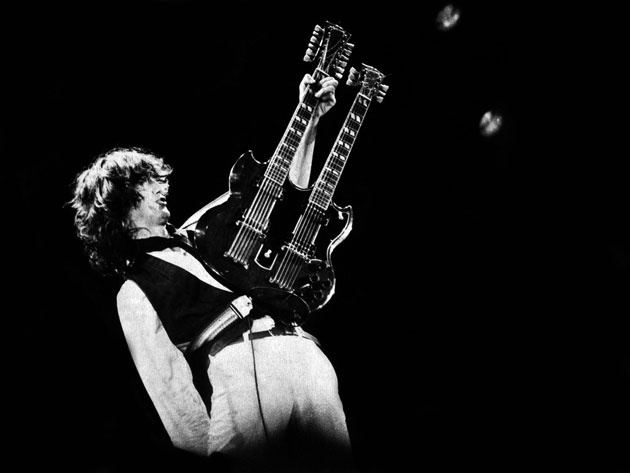
Rock guitarist from the famous group Led Zeppelin Jimmy Page was born on January 9, 1944 in London England. Page picked up a guitar at age 12 and was mostly self-taught, though he did take a few private lessons.
He learned his first chords from his school mate Rod Wyatt, and he learned to play while listening to records. He often played for hours each day and took his guitar to school. Rockabilly guitar players such as James Burton and Scotty Moore had a direct influence on his playing, and he was rooted in blues and acoustic folk playing. He performed with other guitarists such as Jeff Beck and Eric Clapton at the Marquee Club when he was still a student, and he was asked by John Gibb to help record some songs, thus gaining work as a session musician. In 1968, Page joined up with drummer John Bonham, vocalist Robert Plant, and John Paul Jones to form one of the most famous and best-selling rock bands of all time: Led Zeppelin.
Page had a lot of input as musician and producer, and the group were pioneers of hard rock and metal. “Stairway to Heaven,” and “Whole Lotta Love” became record breaking singles. Page wanted the group’s sound to be a combination of rock, blues and acoustic textures. Sadly, John Bonham passed away in 1980. For a while, Page refused to pick up his guitar out of grief, but did start up some individual work and sound track playing in 1981. He has also done charity work for causes such as Multiple Sclerosis.
Page is known for guitar riffs, distorted guitar tones, adjusting the guitar tunings, and also playing his guitar with a cello bow to create a certain effect for the music. He has played on several guitars including a 959 Telecaster, (also known as the Dragon), a Gibson Les Paul Standard, Gibson Les Paul Deluxe, Danelectro, and Fender Stratocaster. He also used 12 string guitars such as the Vox Phantom and Fender Electric XII. Acoustic guitars included a Gibson J-200 and Martin D-28. Signature models of Page were released by both Gibson and Fender.
Page is still active as a musician and performer today, and is widely regarded as one of the most influential guitar players of all time.
Buddy Guy
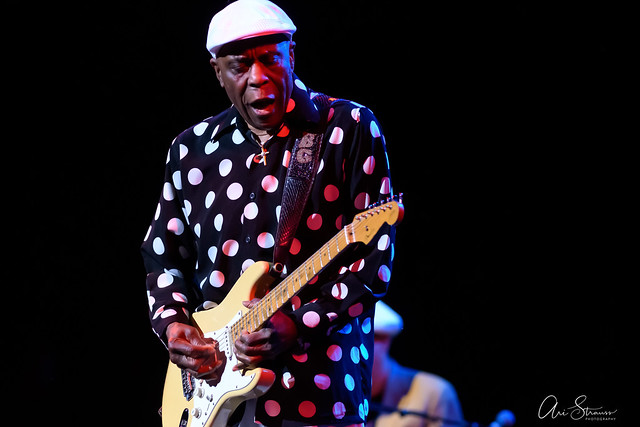
American blues guitarist Buddy (George) Guy was born on July 30, 1936 in Lettsworth Louisiana to parents who were sharecroppers. Using a two string diddley bow, he started learning to play guitar. His first acoustic guitar was a Harmony.
Guy moved to Chicago in 1957, and there he discovered the music of Muddy Waters. Guitarists Magic Sam and Otis Rush gave him a record contract after a competition in 1958. Recordings for Cobra Records soon came afterwards. For his second record, Guy received help from Ike Turner. After that, he signed on with Chess Records. In 1969, he appeared at the “Supershow” in England, which also featured Jack Bruce, Led Zeppelin, and Eric Clapton.
He was very active in the 1980’s and 90’s with the revival in blues music. Guy’s most well know songs include “First Time I Met the Blues,” “Baby Please Don’t’ Leave Me,” “Mustang Sally,” and “Sit and Cry the Blues.” Guy is still an active performer, giving over 100 shows a year. His guitar playing, though often labeled Chicago Blues, is unique, often combining blues with free jazz and avant rock, and is always changing. He had a vitality and originality that could not be matched by other blues players.
Guy was inducted into the Rock and Roll Hall of Fame and is also the recipient of eight Grammy awards. He was also ranked number 23 out of 100 greatest guitarists by Rolling Stone magazine. Guy favored the Fender Stratocaster as his guitar of choice.
He inspired many guitarists such as Eric Clapton, Bill Wyman and Reggie Sears, for his incredible blues playing ability.
John Scofield

Jazz fusion guitarist and composer John Scofield was born in December 26, 1951 in Ohio. He discovered his interest in music when his family moved to Connecticut, and started playing guitar at the age of 11. Scofield was inspired by both blues and rock players. He ended up leaving the prestigious Berklee College of Music to make recordings with Gerry Mulligan and Chet Baker and spent two years recording and playing with the Billy Cobham/George Duke band.
In 1977, his album John Scofield was released with record label Enja. With his teacher Steve Swallow, he formed a trio in 1979 with drummer Bill Stewart. For three and a half years, he also played on three Miles Davis albums, “You’re Under Arrest,” “Star People,” and “Decoy.” Since that time he has formed groups such as his Blue Matter Band, and quartet Blue Note. His groups have produced several successful albums, including “Meant to Be,” “What We Do,” “Grace Under Pressure,” and “A Go Go.”
Scofield’s sound became more soul jazz and funk near the end of his time with Blue Note. His group with piano player Larry Goldings, bassist Dennis Irwin, and drummers Idris Muhammad and Bill Stewart toured quite frequently. Their albums “Groove Elation” and “Hand Jive” feature this style of music. Since the 1970’s, Scofield’s guitar playing has influenced jazz.
His sound is very distinctive with his improvisation. He has favored an Ibanez AS-200 guitar as his first choice. Scofield is a Professor of Music at New York University and he still tours at least 200 days a year.
Stanley Jordan

American jazz guitarist Stanley Jordan was born in Chicago, Illinois on July 31, 1959. He played piano at the age of six, and then switched to guitar when he was eleven. Jordan played with various rock bands in his youth, and in 1976 he won an award at the Reno Jazz Festival.
He studied music theory, computer music and composition at Princeton University. During this time he also played with the famous Dizzy Gillespie and Benny Carter. His first album, “Magic Touch,” set a record, as it sat at number one of the Billboard jazz chart for 51 weeks.
He has recorded 14 albums in total. Jordan is widely known for his touch technique, or advanced two-handed tapping. Doing this technique with both hands, and more smoothly than normal, he is able to play chords and melody at the same time. Jordan also has his guitar tuned differently than the traditional EADGBE that most guitarists use. Instead, he prefers EADGCF, or all fourths. According to him, this method of tuning makes the fingerboard simpler to play.
Jordan favors an Arpege model guitar, which has a very low action, best for his tapping technique. He has worked with many well -known artists such as Richie Cole, The Dave Matthews Band, and Quincy Jones. Jordan’s jazz festival performances include Montreux International Jazz Festival, Concord Jazz Festival and Kool Jazz Festival. He also made the start up sound for several Macintosh computers, and has been nominated for four Grammy awards. Jordan has also played on “The David Letterman Show,” and “The Tonight Show with Johnny Carson.”
He takes pride in his study of music therapy, in which he is pursuing a Masters degree at Arizona State University. When he tours, he often does outreach with hospitals and schools. Jordan has done various lectures on how music promotes healing, and is an active spokesperson for the American Music Therapy Association.
He still maintains a very active touring schedule.
Carlos Santana
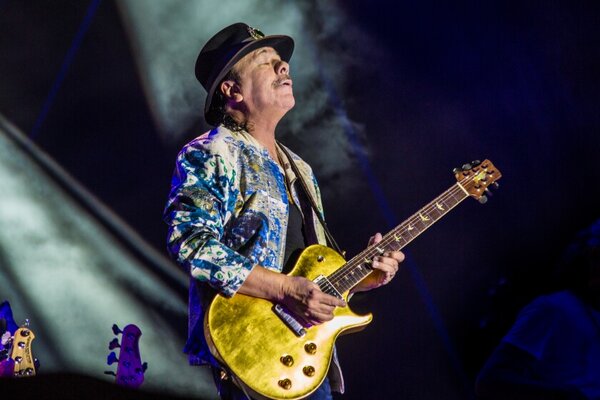
Latin jazz and rock guitarist Carlos Santa was born on July 20, 1947 in Jalisco Mexico. His father was a mariachi musician, so he was exposed to music at an early age. He played violin at the age of five and then started guitar at age 8. Santana was very influenced by Ritchie Valens.
His family ended up moving to California so his father could have steady employment. Santana had several different influences such as Jimi Hendrix, the Beatles, John Coltrane, B. B. King, John Lee Hooker and Mike Bloomfield. He was accepted into University but chose not to attend. Santana joined several local bands and began create to his own sound. In San Francisco he was also exposed to more jazz and folk music. During a performance his guitar playing caught the attention of Bill Graham, who owned an auditorium and often selected substitute musicians. In 1966 Santana formed the Santa Blues band, which blended salsa, African rhythms, jazz, blues and Latin rock together. They immediately became popular locally.
The band recorded it’s first album in 1969 with Columbia Records. It reached number four on the Billboard 200. Their performance at Woodstock gave them international acclaim. Their second album “Abraxas,” was well received with its mix of rock, blues, jazz and salsa. It featured the hits “Black Magic Woman/Gypsy Queen,” and “Oye Como Va.” In 1986 it went four times platinum. Their third album “Santana III” was yet another hit, reaching number one. The group would go on to with three Latin Grammy Awards and 10 Grammy Awards.
In 1998 they were inducted into the Rock and Roll Hall of Fame. Santana has used various Gibson Les Paul guitars. PRS Guitars started making Santana signature guitar models in 1988. Some of these styles feature Brazilian rosewood and the necks have mahogany with rosewood fret boards on top. Santa’s guitar playing features a lot of tremolo picking and long sustained notes. He does include common positions along the neck of the guitar along with use of the pentatonic scale. His playing has a Latin feel with use of the Dorian mode.
Not known for speed, Santana uses rhythm and phrasing to achieve his sound. Santana is still actively performing and recording.
Jeff Healey
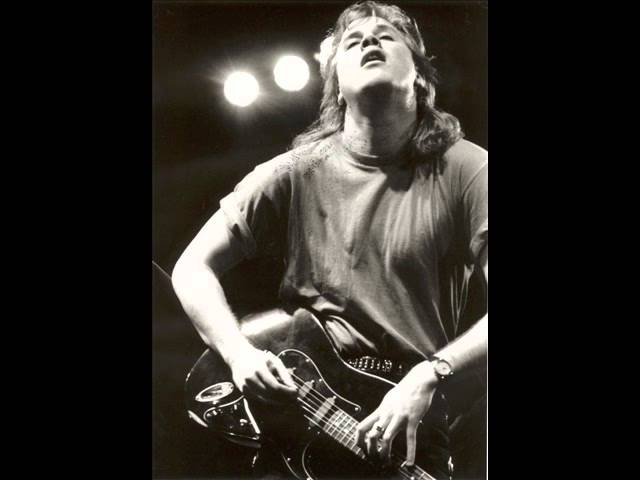
Canadian singer and guitarist Jeff Healey was born on March 25th, 1966 in Toronto, Ontario. Unfortunately, when he was only a year old, he lost sight in both eyes to a rare form of eye cancer. His eyes needed to be removed and were replaced with prostheses.
Healey began playing the guitar at the age of three in a unique way-on his lap, with the strings facing upwards. He appeared on the children’s show “Cucumber” at the age of 9 showcasing his guitar talents. The Band Blue Direction was then formed when Healey was 15 including Jeremy Littler, Rob Quail and Graydon Chapman. They primarily played cover tunes at local clubs in Toronto, and Healey also started hosting a blues program on a radio station. He then met drummer Tom Stephen and bass player Joe Rockman, and the three formed the Jeff Healey Band. The group played a show at The Birds Nest in Toronto, and then received an article in NOW magazine.
Healey was then discovered by blues guitarist Stevie Ray Vaughan. His first album, “See the Light” was released with Arista Records in 1989 and featured the hit song “Angel Eyes,” and “Hideaway.” The latter was nominated for Best Rock Instrumental Performance at the Grammy Awards. Healey also acted in the film Road House with Patrick Swayze, and the band also recorded for the movie’s soundtrack. Healey’s band won the Juno Award for Canadian Entertainer of the Year in 1990. He had several hit singles on the albums “Feel This” and “Hell to Pay” during the years between 1990 and 1994. Healey’s focus had turned to jazz by the year 2000, and he went on to release three CD’s of American jazz.
An avid record collector, he had a collection of over 30,000 records. Healey toured through both Europe and North America, and had his own club called “Healey’s’ ‘ in Toronto. He also helped with the careers of other artists such as Amanda Marshall, Terra Hazelton and Philip Sayce. The Terry Fox Hall of Fame inducted him in 2009, and he was inducted into Canada’s Walk of Fame in 2014. Healey was known for his ability to perform string bends and vibrato easily, along with his distinctive phrasing. He favored the Squier Stratocaster for his guitar playing.
Unfortunately, Healey died at the age of 41 from sarcoma in Toronto.
Oz Noy
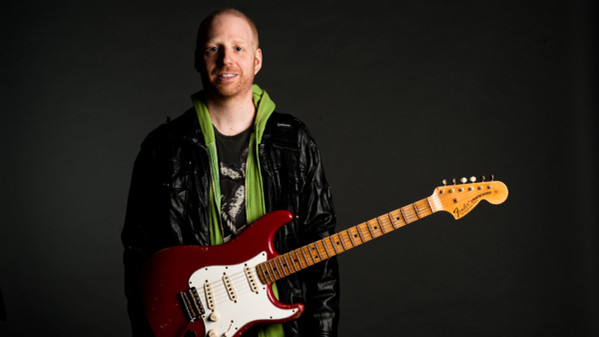
Oz Noy is a virtuoso guitar player whose style blends jazz, rock, funk R&B and blues together. Noy was born in Israel and at 13 started his professional career playing pop, jazz and rock music. He was playing with renowned artists from Israel by age 16, and became established as a top guitar player by age 24 in Israel.
Noy moved to New York in 1996 where he made an impression on the music scene, both locally and internationally. Musicians who play with him include Anton Fig, Dave Weckl, and Keith Carlock. His debut record was released in 2003 called “Oz Live.” Noy signed with Magna Carta records in 2005 and his album “Ha!” was released. He also signed a licensing deal with Japan label Videoarts and Magna Carta. Several successful albums followed. Noy has several accomplishments, including the Guitar Player reader’s poll for Best New Guitar Player and Best guitar riff on a record.” Noy has also released several guitar instructional videos.
At the Collective School of Music in New York, he conducts master classes. He uses Fender, Yamaha, and Gibson guitars. Noy is one of today’s most creative jazz fusion artists, and is able to creatively blend funk rock and blues with jazz. He maintains an active teaching and performing career. Noy gives private instruction to students of all ages, but prefers students to be at an intermediate level when signing on with him.
In state of the art studio, he can record and produce tracks for musicians anywhere.
Lenny Breau
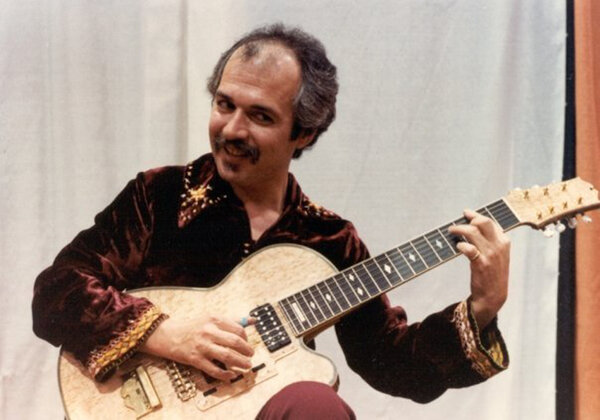
Canadian-American guitar player Lenny Breau was born on August 5th, 1941. Breau opened up many possibilities for the guitar as he approached playing it like a piano. Born in Auburn, Maine in the U.S., his family moved to New Brunswick Canada in 1948.
Both of his parents were professional musicians who recorded from the 1930’s until the 1970’s. Breau started playing guitar himself when he was eight, and formed his first band with friends at the age of 12. He became the lead guitar player in his parents’ band when he was 14. At 15 he was working as a studio musician and making his first professional recordings. In 1957, Breau’s family moved to Winnipeg, Manitoba. Their shows were broadcasted on the radio station CKY on Saturday mornings. Breau left his family’s band, as he and his father disagreed on using jazz improvisation in music.
After meeting jazz pianist Bob Erlendson, he began learning the foundations of jazz. Breau moved to Toronto in 1962 and founded the group Three. They played in New York, Ottawa and Toronto, and their music was featured in a documentary called “Toronto Jazz.” When he returned to Winnipeg, Breau did recordings for CBC Radio, and had his own show called “The Lenny Breau Show.” Breau had a heavy influence on Randy Bachman and Neil Young, other famous Winnipeg musicians, who he played with regularly at the club Fourth Dimension. Breau’s first two albums were titled “Guitar Sounds From Lenny Breau” and “The Velvet Touch of Lenny Breau Live!.”
In 1976 he moved to the United States and lived in California, Nashville, Maine and New York City. He eventually settled in Los Angeles in 1983. During this time, he worked for Guitar Player magazine writing articles, and did teaching and performing. Breau’s daughter created a documentary called “The Genius of Lenny Breau” in 1999. The video featured Ted Greene, Lenoard Cohen and Chet Atkins giving interviews about his talents.
In 1997, he was inducted into the Canadian Music Hall of Fame. Breau’s music combined flamenco, jazz, country and classical together. He used fingering techniques that were not usually used in jazz guitar. Playing on a seven-string electric guitar, his technique resembled finger picking like that of Chet Atkins. The flamenco style was also present with the independence in the right hand and harmonics. For harmony, he used influences of modal music and classical music. Breau had two custom seven string guitars made for him, with the seventh string tuned to a high A.
He passed away on August 12, 1984.
Al Di Meola
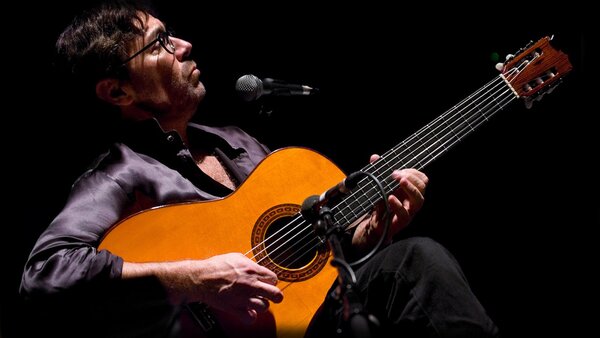
Known for his work in world music and jazz fusion, guitarist Al Di Meola was born on July 22, 1954. Di Meola’s family was originally from a small town in Italy, but he was born in New Jersey. At the age of eight, he started playing the guitar and was largely inspired by Elvis Presley. Other influences were jazz guitarists Kenny Burrell and George Benson. In 1971, Di Meola attended Berklee College of Music.
Chick Corea then hired him for the band Return to Forever when he was 19 years old. All three of their albums made it into the top 40 on the Billboard charts in the U.S. They also won a Grammy award. After the groups break up in 1976 Di Mieola began his career as a solo artist. His albums mixed flamenco, Mediterranean, and jazz. “Elegant Gypsy” was given a gold certification. He became known for very fast and difficult guitar solos and writing, as well as his technical mastery of the instrument. Songs such as “Lady of Rome,” and “Sister of Brazil,” demonstrate such artistry.
His album “Friday Night in San Francisco” sold more than two million copies, and became one of the most popular albums for acoustic guitar. Di Meola began using electric guitar again in 2006. He became a recipient of the Miles Davis Award for his contributions to jazz at the Montreal Jazz Festival in 2015. He was awarded an honorary doctorate of music from Berklee in 2018. Di Meola has used many Gibson guitars over the years including a Les Paul Black Beauty and Gibson Sunburst Les Paul. He is still actively touring and performing today.
His sophisticated lyrical melodies as well as his complex rhythm syncopations have given him critical acclaim for over four decades.
Paco de Lucia
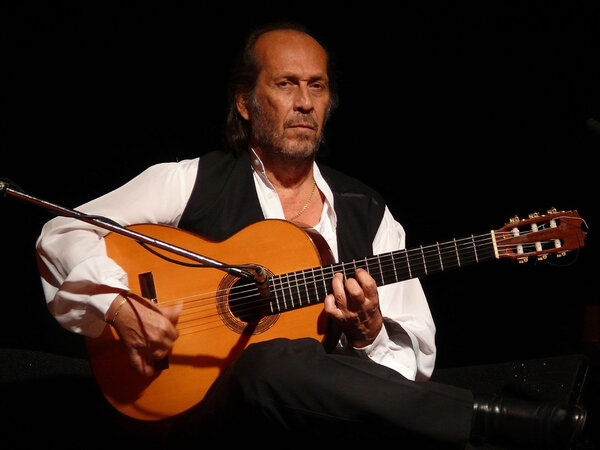
Considered to be the world’s leading flamenco guitarist, Paco de Lucia was born on December 21st, 1947 in south Spain. His father was a flamenco guitarist himself and he had four other siblings. As a young child Lucia’s father taught him to play guitar, and it was expected that he practice for many hours a day. De Lucia was even pulled from school so he could focus on guitar and better his chances of being able to do music professionally. Their relationship is quite similar to that of Leopold Mozart and his son Wolfgang.
With his brother Pepe, de Lucia made his first record at 14 years old. He then toured with Jose Greco, a flamenco dancer in the early 1960’s. He met his mentor Mario Escudero at the age of 15, who convinced him to write his own songs. His albums early on had recorded classics like “Malaguena” and other flamenco recordings. At the Berlin Jazz Festival in 1967, he met Miles Davis, which had a strong impact on de Lucia and influenced him in regards to jazz music. He then toured across Europe and met Camaron de la Isla, a singer who he collaborated with on ten different albums. This partnership had strong influences on flamenco music.
De Lucia recorded many albums with his brother Ramon, as well as touring with him. In 1972 he released the album “El Duende Flamenco de Paco de Lucia,” which in the flamenco community was groundbreaking. His best known composition “Entre dos Aguas” combined innovative styles of flamenco with jazz. During the 1970’s de Lucia toured across Europe and the United states constantly. He performed with Carlos Santana in Barcelona, showing an interest in rock and jazz fusion. In the 1980’s his trio released “Friday Night in San Francisco,” a highly successful record which created interest in flamenco music in America. De Lucia released two more albums in 1983 and 1984. In 1990, his group recorded with jazz piano player chick Core on a new flamenco album, which was critically well received. In the 2000’s he continued to both record and tour successfully.
He is the recipient of a Latin Grammy Award as well as the Prince Of Asturias Award. De Lucia was considered by many to be not only Spain’s greatest musical export, but also the world’s leading flamenco guitarist. He was the first Spanish musician to mix flamenco and jazz together, and break away from the traditional flamenco form. He used colorful harmonies and had amazing technique and dexterity. Typical of his playing were picados as well as abstract chords, and he was known for contrast. De Lucia is known for also influencing other guitarists like Eric Clapton. He liked to play on Conde guitars.
De Lucia passed away from a heart attack on February 25, 2014.
Lionel Loueke
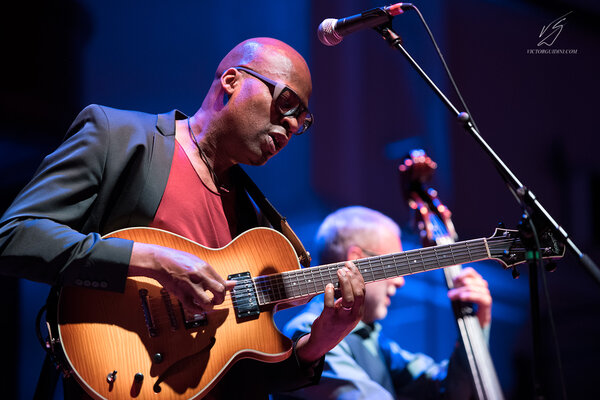
Jazz guitarist Lionel Loueke was born on April 27, 1973 in Benin, a country of West Africa. He started playing percussion instruments at age 9, but started playing guitar under the influence of his older brother when he was 17. His influences were Joe pass, Wes Montgomery and Kenny Burrell. Loueke studied at several schools including the National Institute of Art in Ivory Coast, Berklee College of Music,
The American School of Music I Paris, and finally, the Thelonious Monk Institute. A club’s manager gave Loueke his first job after hearing him play. He enjoyed playing African pop music, but then turned to jazz once he heard an album by George Benson. He has appeared on Terence Blanchard’s albums “Flow” and “Bounce,” and on Herbie Hancock’s “Possibilities.” Other artists he has worked with include Cassandra Wilson, Dianne Reeves, Sting, Santana, and Brian Blade.
His trio Gilfema recorded albums “Gilfema” and “Gilfema +2.” In 2008, he released his album “Karibu” under the label Blue Note, and his combination of jazz harmony and African music with difficult time signatures was praised. Loueke is known for using finger style picking along with drumming techniques on the guitar for a very individual style. He has used Godin Multiac Nylon guitars, a black Godin 5th Avenue, PRS LP Style, Yamaha Silent guitar, and Yamaha AEX1500 acoustic, among others. Loueke has won several awards including Best Traditional Song at the Independent Music Awards, A Fellow Award from the United States Artists, and World Music Album of the Year.
Loueke maintains an active playing and recording career as well as teaching.
Tosin Abasi
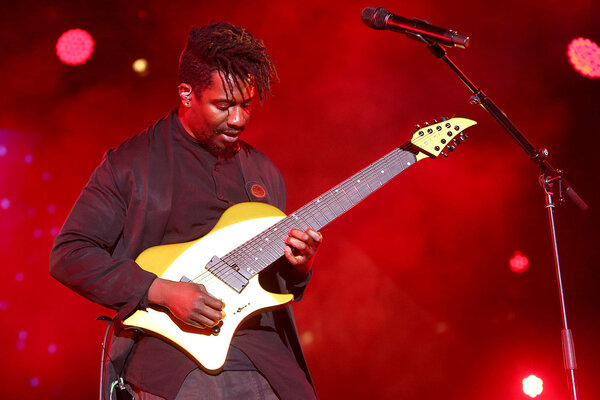
Metal guitarist Tosin Abasi was born on January 7th, 1983 in Washington D.C. His parents were immigrants from Nigeria. Tosin picked up the guitar on his own in elementary school, and is largely self-taught. He learned through metal guitar instruction videos, and soon was making up his own licks and teaching himself to strum. He was largely supported by his father who bought him his first guitar.
Abasi’s first metal group was called PSI, and he joined Reflux in the early 2000’s. He was offered a record deal by Prosthetic Records after they saw him play a Reflux show, which he refused. He then became a student at the Atlanta Institute of Music and Media. Upon graduation, he contacted the record label and asked them if he could still have a deal. His group Animals as Leaders was then formed. Their first album was recorded in 2009. After it was finished the group started touring full time. “Weightless,” the group’s second album, was released in 2011, and their third album was released in 2013. T.R.A.M., his new band was formed in 2011 so he could let out some musical ideas that he felt would not fit with Animals as Leaders.
Abasi appeared in Rolling Stone magazine in 2014. Abasi’s signature guitar, the Ibanez Tam 100, was released in 2013. He chose to leave these guitars in 2017 as he wished to include different features such as 6 string options and locking tuners. Abasi’s Concepts guitars were then founded. These guitars feature ergonomic designs, unique wood combinations, and are 6, 7 and 8 string varieties. Abasi credits artists such as Steve Vai, Thom Yorke, and Mike Einziger for influencing his guitar playing. He makes unusual sounds by using different techniques to produce them. Abasi is well known for heavy single note rhythm riffs, and uses slapping and popping techniques.
Abasi is still an active performing musician.
Interested in learning how to play guitar?
Take guitar lessons today!
Adult Music Lessons – “Am I Too Old To Learn”?

